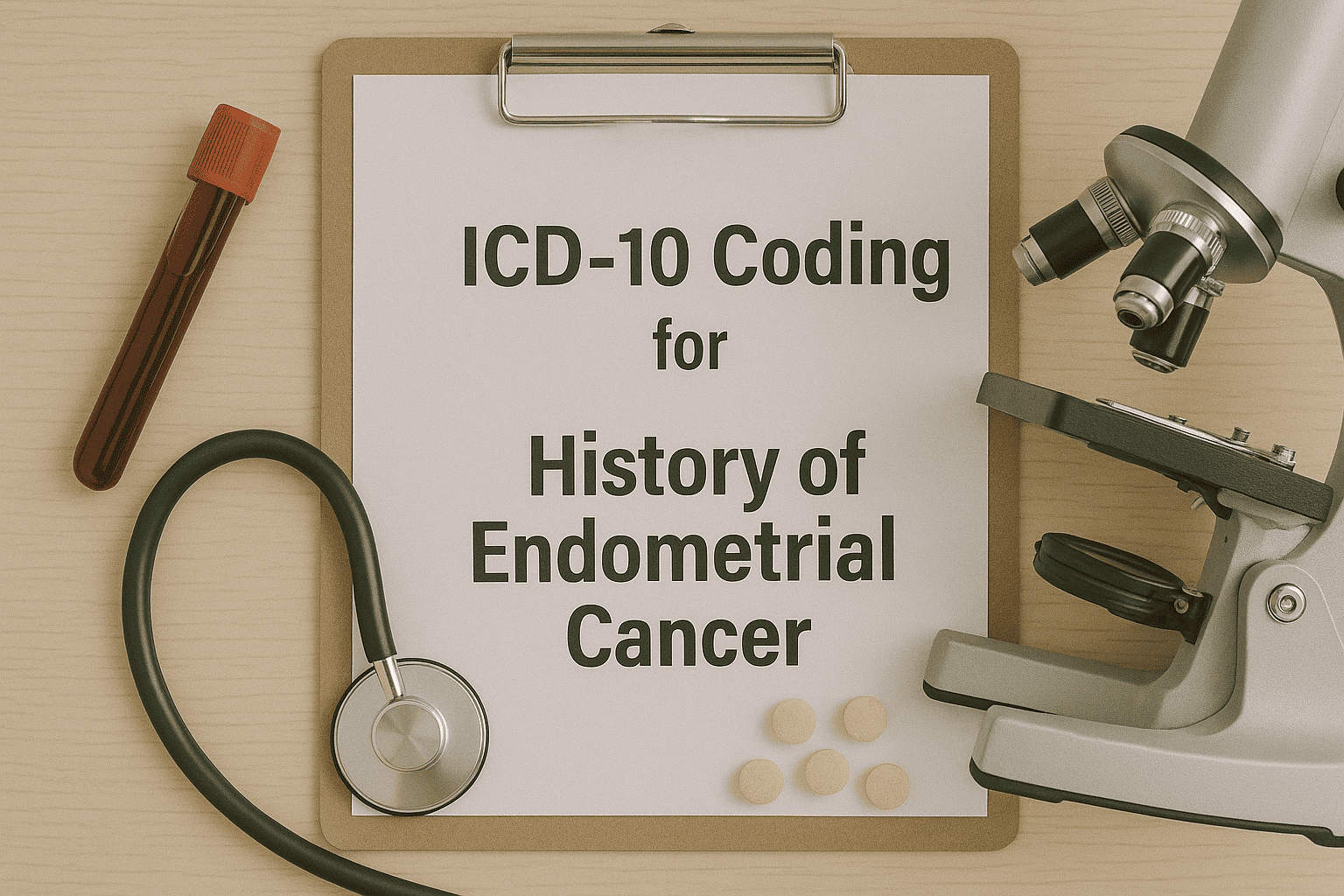Updated on: July 23, 2025
When managing a patient with a history of endometrial cancer, clinicians must consider more than just the cancer itself. From long-term surveillance and treatment side effects to recurrence monitoring and appropriate documentation, capturing this history correctly is vital—clinically, legally, and for coding compliance.
In this article, we’ll walk through what a history of endometrial cancer means in practice, how to code it accurately using ICD-10, and how DocScrib can help automate and improve your clinical documentation in seconds.
🔗 Learn more at DocScrib.com – Your AI-powered assistant for smarter medical charting.
What Does “History of Endometrial Cancer” Mean Clinically?
A history of endometrial cancer refers to a patient who was previously diagnosed with cancer of the uterine lining, completed treatment (surgery, radiation, or chemotherapy), and is currently not undergoing active treatment. However, this history remains clinically significant for:
-
Surveillance and recurrence risk
-
Hormonal replacement considerations
-
Management of comorbidities
-
Fertility, sexual health, and psychological impact
🧠 Clinical Note: Documenting this history supports continuity of care, informs future gynecologic evaluations, and ensures appropriate screening and coding.
Why Proper Documentation of Cancer History Matters
| Reason | Clinical & Operational Impact |
|---|---|
| Surveillance planning | Tailored imaging, pelvic exams, and labs |
| Treatment decisions | Avoid hormonal therapies that may trigger recurrence |
| Comorbidity documentation | Tracks treatment side effects (osteoporosis, lymphedema) |
| ICD-10 compliance | Supports billing, risk adjustment, and quality metrics |
| Care coordination | Helps oncology, gynecology, and primary care teams align |
ICD-10 Coding for History of Endometrial Cancer
Once endometrial cancer has been successfully treated and the patient is no longer receiving active therapy, the appropriate code is from the Z85 series, which denotes a personal history of malignant neoplasm.
Primary ICD-10 Code for History
| ICD-10 Code | Description |
|---|---|
| Z85.42 | Personal history of malignant neoplasm of the uterus, endometrium |
✅ Use Z85.42 when the patient has a resolved case of endometrial cancer and is under surveillance or follow-up.
❌ Do not use active cancer codes (like C54.1) unless the patient is currently being treated or has documented recurrence.
Case Example: Post-Treatment Surveillance Visit
Patient: 63-year-old female with stage IA endometrial cancer treated with total hysterectomy and brachytherapy three years ago. No recurrence. Here for annual check-up.
Traditional Workflow:
-
Note written manually
-
Code either omitted or inaccurately documented
-
Missed opportunity for history inclusion in claim
DocScrib Workflow:
✅ Detects:
-
Past cancer diagnosis
-
No active treatment
-
Post-hysterectomy status
✅ Suggests ICD-10: Z85.42
✅ Auto-generates note:
S: Patient here for routine follow-up. Reports no pelvic pain, bleeding, or recurrence symptoms. Last oncology visit 6 months ago.
O: Abdomen soft, non-tender. No lymphadenopathy. No signs of recurrence.
A: History of endometrial cancer (Z85.42). No evidence of disease.
P: Continue annual surveillance. No imaging indicated at this time.
🩺 One click to EHR. Fully compliant and billable.
When to Use Related ICD-10 Codes
| Scenario | ICD-10 Code |
|---|---|
| Active endometrial cancer | C54.1 |
| History of endometrial cancer, no active disease | Z85.42 |
| Follow-up after treatment, no findings | Z09 + Z85.42 |
| Post-surgical state (e.g., hysterectomy) | Z90.710 |
| Menopausal symptoms post-treatment | N95.1 or N95.2 |
| Hormone therapy monitoring | Z79.890 |
💡 Pro Tip: Use Z09 (encounter for follow-up after completed treatment) alongside Z85.42 when no evidence of disease exists and follow-up is the primary reason for the visit.
Long-Term Monitoring in Patients with History of Endometrial Cancer
Recommended Follow-Up Schedule (NCCN Guidelines)
| Time Since Treatment | Recommended Follow-Up |
|---|---|
| Year 1–2 | Every 3–6 months |
| Year 3–5 | Every 6 months |
| After 5 years | Annually (or as clinically indicated) |
🧬 Encourage patients to report vaginal bleeding, pelvic pain, or urinary symptoms immediately, even years after remission.
How DocScrib Simplifies Oncology Documentation
DocScrib is your AI-powered medical scribe that automatically captures patient history, flags important coding opportunities, and writes SOAP notes and ICD-10 codes in real time.
| Feature | Without DocScrib | With DocScrib |
|---|---|---|
| ICD-10 Code for History | Often missed or misapplied | ✅ Suggested instantly |
| Surveillance Note Templates | Written manually | ✅ Auto-generated based on visit |
| Post-Treatment Care Plans | Fragmented | ✅ Seamlessly embedded |
| Coding Accuracy | Error-prone | ✅ Auto-matched to context |
| Provider Time Spent Per Visit | 7–10 mins documentation | ✅ <1 minute with AI support |
🗣️ “DocScrib helps me capture resolved cancer histories cleanly, without repeating the entire treatment summary in every visit.”
— Gynecologic Oncologist, California
FAQs: History of Endometrial Cancer & Documentation
Q1: Can I bill Z85.42 as a primary code?
Yes, especially when the visit is for follow-up or related complaints post-treatment. Pair it with Z09 when appropriate.
Q2: What if the patient has recurrence or new symptoms?
If there’s evidence of active disease or new diagnosis, use the appropriate C54.x code based on tumor location.
Q3: Should I mention surgical history separately?
Yes. If a hysterectomy was performed, code Z90.710 to denote organ removal, especially if it affects treatment options.
Q4: Does DocScrib handle cancer histories across specialties?
Absolutely. Whether you’re in oncology, OB/GYN, or primary care, DocScrib adjusts notes and codes based on clinical context.
Final Thoughts: Turn Past Cancer Into Present Care Clarity
A history of endometrial cancer should never be an afterthought. It influences medication decisions, hormonal management, screening frequency, and emotional support needs.
With DocScrib, you can:
-
Auto-code Z85.42 with confidence
-
Document clean, structured follow-up notes
-
Improve compliance and reduce errors
-
Save time, so you can focus on what matters most—your patients
📅 Book a Free Demo Today
🔗 Or explore more at DocScrib.com
